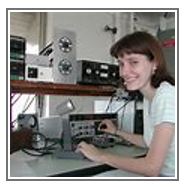By Jaime Yarbrough, Science Editor – April 29, 2021
What am I about to read? Why do I need to read it? How will it make my life better?
Today class, we will be talking about a different side of ‘science’ than one might think of, communications. Communications is generally thought of as more of an art than a ‘science’ but in the context of the mode it employs it can easily involve some very deep and interesting science.
Take email or texting for example. Electronics, computers are easily considered elements of science. So is the television and RADIO (AM/FM) that everyone is familiar with. The type of RADIO I will be talking about today is “amateur RADIO” or
HAM Radio operations. (References at the end).

As President of the Del Norte Amateur Radio Club (W6HY.org) in my second term I thought what better place to talk about the science and art of being a HAM operator than here in Crescent City Times.
Almost everyone believes Benjamin Franklin was the first person to discover electricity with a key and his kite. He was the first to prove electricity in nature, however Michael Faraday is claimed to be the Father of Electricity, and William Gilbert share the title. Following the discovery of electromagnetism by Hans Christian Ørsted in 1820 and the invention of the electromagnet by William Sturgeon in 1824, there were many developments in electromagnetic telegraphy in Europe and America.
Similarly there are those who will argue about who was the first to send a message through the air but, Guglielmo Marconi, is usually given credit. Once the electromagnetic cat was out of the bag inventors were everywhere. Hertz, Maxwell, Bell, Edison, Volta, Tesla, Henry were some of the big names but there was no shortage of people trying to harness the power of electricity for communication.
In the path of communicating over long distances before the perfection of voice transmission and reception there was ‘continuous wave’ or CW. The method of short and long bursts of energy was standardized by Samuel Morse in what we now call Morse Code. The first appearance of code was in the form of punched paper tape. Sound came later. First adopted in 1844 it has enjoyed a long, long and very interesting history.
Without going into the long history of the development of RADIO from the discovery of electricity save it enough to say that by 1909 there were 89 amateur radio stations in Europe, Britain and America passing messages (traffic) back and forth. While Alexander Graham Bell’s telephone was invented earlier it required a wire and radios bounced signals off the electromagnetic layers that surround the earth and, can do so if the signal has the strength to do so.
SO, let us fast forward a bit. Amateur radio is a special ‘class’ of radio operation that required a Federal Communications Commission (FCC) license because of the methods and frequencies it operates on. The electromagnetic spectrum is an exceptionally large place, and it is sliced into thousands of slices that are closely monitored so everyone can use them freely. There are established rules to prevent abuse and maintain order not unlike the traffic rules of the road. For the most part, sort of like the internet but not, it is somewhat self-policing. There is only a problem when someone steps out of line. They get reported and receive a warning, then a fine, and then the legal system kicks into gear.
Amateur radio started out an experiment, then quickly turned into a utility, then a hobby and at the same time a vital backbone in the case of emergencies. Currently there are well over 700,000 operators in America with over 2 million around the world. When the infrastructure (towers, telephone lines, and transmitting stations) is obliterated by a typhoon, hurricane, tidal wave or earthquake, someone with a
hand-held amateur radio can communicate when other forms of communication cannot. There is even a way for a personal radio to use the internet and communicate to just about any place on Earth!
There are several levels of being a HAM operator. Each has rights, responsibilities, and capabilities as one ascends. The basic level is Technician class. There are resources and occasionally a class given to help people take and pass the FCC exam. Once you have your license and a radio it will open a
new world with fellow HAM’s. It is a great hobby and there are plenty of friendly people out there willing to help you.
Visit the W6HY. ORG website for more information.
Jaime Yarbrough
President DNARC
KJ6JKL
References;
https://en.wikipedia.org/wiki/Amateur_radio
https://en.wikipedia.org/wiki/Invention_of_radio
https://en.wikipedia.org/wiki/Morse_code#Development_and_history
https://en.wikipedia.org/wiki/Invention_of_the_telephone

